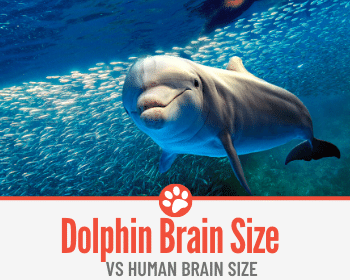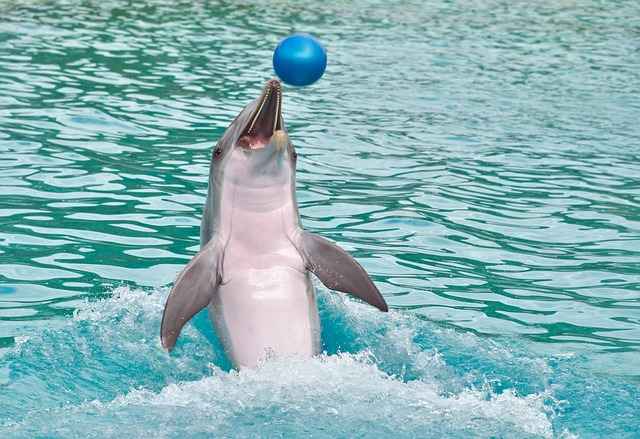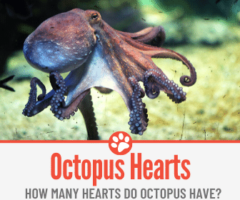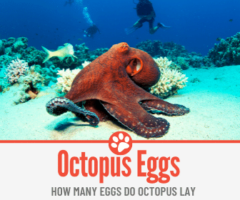 I had a friend that told me he did not like to swim in the ocean because in the water we are no longer the dominant species. There are creatures that swim faster, can hold there breath longer, and dive much deeper than us.
I had a friend that told me he did not like to swim in the ocean because in the water we are no longer the dominant species. There are creatures that swim faster, can hold there breath longer, and dive much deeper than us.
The ocean is also home to the world’s second smartest creature, the Dolphin.
With brains larger than humans and abilities we can only call superpowers, Dolphin’s are the darlings of the ocean, but it is also time to recognize their brilliant minds.
How Big Is A Dolphin Brain?
Research shows that on average, adult dolphins have an absolute brain mass of 1500 grams. This, of course, varies from species to species but it is larger than the absolute brain mass of humans, which ranges from 1300g to 1400g.
Dolphins however have a brain-to-body mass lower than that of humans. It is not simply the size of the brain that matters.
Dolphins have an incredibly complex neocortex, which is the part of the brain science and studies in evolution point to being responsible for the evolution of human intelligence. To simplify, a complex neocortex most often means high intelligence.
Why Are Dolphin Brains So Big?
Dolphins are voluntary breathers. This means that they consciously control their breathing, even when sleeping. Dolphins, just like humans, experience REM sleep, or deep sleep.
Studies have shown that Dolphins only sleep one side of their brain at a time. This is to control their breathing, but also to have some sort of awareness of their surroundings and be wary of predators. That is why their brains are so large.
Dolphins also have a whole are of their brain dedicated to echolocation, their ability to see with sonar.
Because sound travels much better in water, Dolphins use this amazing ability to communicate, hunt, and see in dark waters.
Their echolocation abilities are so evolved that they can use sound to see details in their surroundings, look at each other’s pregnancies, and eavesdrop on other echolocation sounds.
Do Dolphins Have Two Brains?
Dolphin’s do not have two brains, but because they can sleep half of their brain it almost feels that way doesn’t it? When humans and other mammals sleep, both hemispheres of the brain sleep.
When humans and other mammals are awake, both hemispheres of the brain are alert and functioning. But Dolphin’s can sleep each hemisphere of their brain at different times.
This is mostly for survival purposes, so they can rest but simultaneously are alert to their surroundings. They are essentially doing two things at once.
Dolphin Cerebral Brain Capacity
The neocortex is the part of the brain that is responsible for self-awareness and problem solving. Dolphins also have special brain cells called spindle neurons, which are associated with abilities such as recognising, communicating, remembering, adapting to change, and understanding.
Additionally, their limbic system, which is the part of their brain responsible for processing emotions, seems to be far more complex than our own. Their forms of communications, such as clicks and whistles, are an enigma to humans. This form of communication may seem simple.
Humans have words and languages and grammar, Dolphins have sounds. But research has shown that this form of communication is incredibly complex.
Clicks are used for echolocation, whereas whistles are used to communication.
They are incredibly chatty and social creatures. They play, joke, and even have their own names, or signature whistles.
They use these signature whistles to identify and call to one another. Mothers teach their infants their names at a young age. When greeting each other at sea, they exchange their names and can remember the names of other dolphins for decades.
It is incredibly exciting to think that Dolphins chat to each other, exchange information, the same way humans to, in a language we will probably never understand.
How Much Brain Capacity Do Dolphins Use?
There is currently not much information about exactly how much brain capacity dolphins use and a lot more research needs to be done for this. But if you’d like to dive a little deeper into Dolphins and their intelligence, you can read more about it here.
Dolphin Brain Size Across Species
The size of a dolphin brain varies across species, but it is safe to say that they are all large brained mammals.
Common Dolphin
The average absolute mass of a dolphin is 1500 grams.
Spinner
Lori Marino, Keith Sudheimer, William McLellan, and John Johnson published a study called the Neuroanatomical Structure of the Spinner Dolphin Brain From Magnetic Resonance Images. In their study, based on MRI, the whole-brain volume of their Spinner Dolphin specimen weighed in at 498.5 grams.
Bottlenose
Bottlenose Dolphins have an absolute brain mass of 1500g – 1700g. In comparison, humans have an absolute brain mass of around 1300g- 1400g.
Whale Dolphin
Whales have the largest brain mass of any existing animals. On average, the absolute brain mass of an adult male weighs in at 7.8 kilograms.
Irrawaddy
There is currently no information available about the exact absolute brain mass of a Irrawaddy Dolphin. Their appearance in similar to that of a beluga whale, which has a brain mass of around 2200 grams, but are most closely related to the killer whale, which has a brain mass of around 6215 grams.
Dolphin Brain Vs. Human Brain
We have established that Dolphins are extremely intelligent. The size of their brains is second to humans. As large-brained species we have certain thing we share, maybe things we often don’t really think about.
We live long lives, we experience complex emotions, we are a sociable species. In terms of reproduction, females give birth to a few babies throughout their lives and are caregivers and teachers to their offspring.
Parents are responsible for teaching life skills, babies take their time to grow up, learn what it means to be independent and self-sufficient until they become sexually mature and are able to live independently.
It’s hard to know whether I am describing humans or dolphins, am I right? That is because both dolphins are humans share this experience.
Dolphin Intelligence Vs. Human Intelligence – Are Dolphins As Smart As People?
Humans are perceived as the dominant and most intelligent species. But isn’t it sort of impossible to be so sure of that statement? We have deemed such incredible animals such as dolphins as less intelligent than we are, but how can we even compare?
Dolphin’s can’t take the Mensa IQ test; we can’t ask them to recite poetry or perform any other task that defines human intelligence.
Dolphins communicate in a completely different way, their lives and their abilities are adapted to a life underwater, where we have a life above it.
We cannot decipher their messages, nor can we replicate their seemingly magical or alien abilities of echolocation. Our brains are different, yet we are capable of doing the same things.
Problem-solving, empathy, the ability to feel pain, joy, loss, the ability to play or be self-aware, these are signs of intelligence and what scientists define to be intelligence.
As humans we often identify with apes, probably because we see most of ourselves in them. The way they walk, their facial expressions.
However, by comparison, the absolute brain mass of the chimpanzee is 400 grams. Dolphin brains are actually the closest to human brains.
Their brains may be larger and used for different abilities, but their intelligence is on par with ours.
Dolphins can recognise themselves in mirrors. Studies have shown that dolphins will check themselves out in a mirror and look at parts of themselves that they couldn’t before, such as the inside of their mouth.
They can understand human gestures and can learn to communicate with humans through underwater keyboards. This ability to learn, adapt, and understand is similar to human youngsters.
Some researchers have come so far as to describe dolphins as nonhuman persons. This may be stretch but let’s think about this.
Dolphins are alive, they have emotions, they are aware of themselves and their surroundings.
They also have personalities, they know how to treat others, they form friendships and emotional connections, and they have self-control. Are these traits not what it means to be a person, to be human?
Dolphins are most definitely as smart as humans, possibly even smarter.
Do Dolphins Use More Of Their Brain Than Humans?
This is a complex question as there is no definite answer to how much for their brains Dolphins use versus how much of our brains we use.
However, studies have shown that the long-finned pilot whale has more neocortical neurons than any other mammal that has been studied. This includes humans.
It was also found that the brain stem transmission time of a dolphin is much faster than that of humans.
The area of the brain devoted to acoustical imaging is 10 times as large as that of humans.
This is all down to the fact that Dolphins rely on sensory processing and a faster processing of sound since their primary sense is echolocation.

What Is The Average IQ Of A Dolphin?
It is impossible to define the IQ of a Dolphin, because our methods of deciding IQ’s are specific to human brains and in use require tasks and thinking that is specific to humans. We can’t ask Dolphin’s to solve math problems, but that does not mean we are smarter.
Scientist use something called EQ’s (encephalization quotients) as an indicator of animal intelligence. EQ’s are provided by comparing the actual brain size with to the body-to-brain ratio. Dolphin’s have an EQ of above 5, whereas humans have an EQ of 6.54.
To conclude, Dolphin’s are amazing and wonderful with abilities that are far beyond our understanding.Dolphin’s have big and beautiful brains and the truth is we could probably learn a lot from them. Above all, Dolphin’s are kind and intelligent creatures.
We have all heard the stories of Dolphin’s saving humans from shark attacks or bringing humans safely back to shore in a crisis. We have so much more to learn about the world around us and all the wonderful creatures in it and maybe one day we will find a way to communicate with all them.
How exciting would that be.






